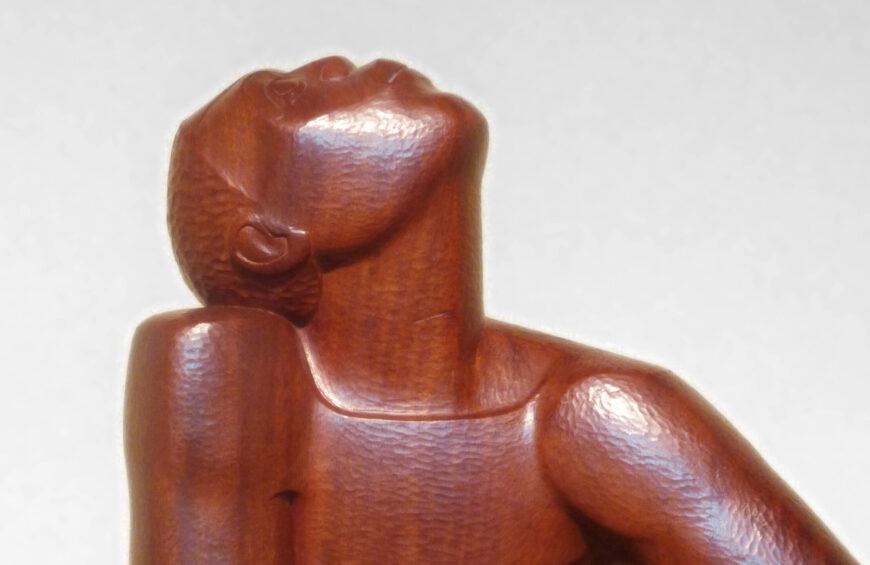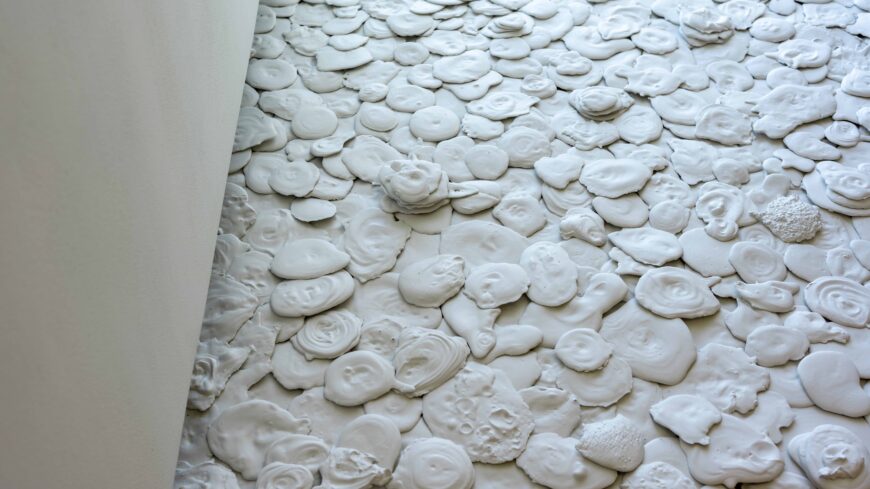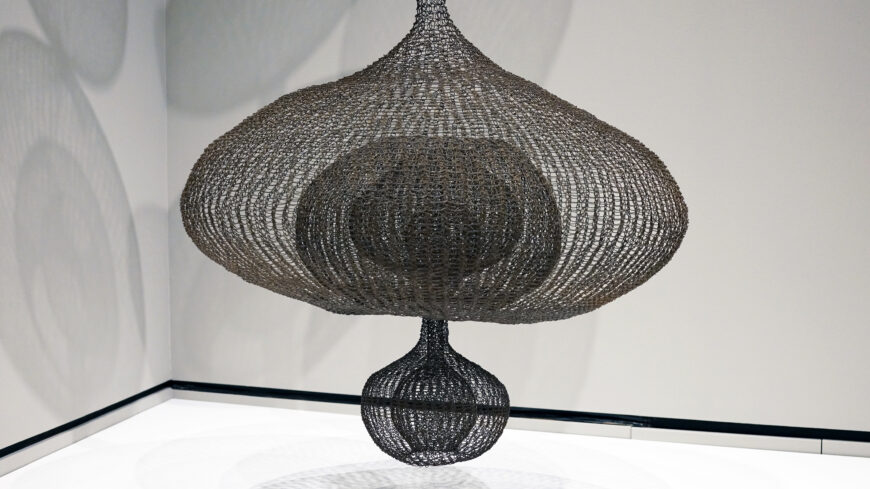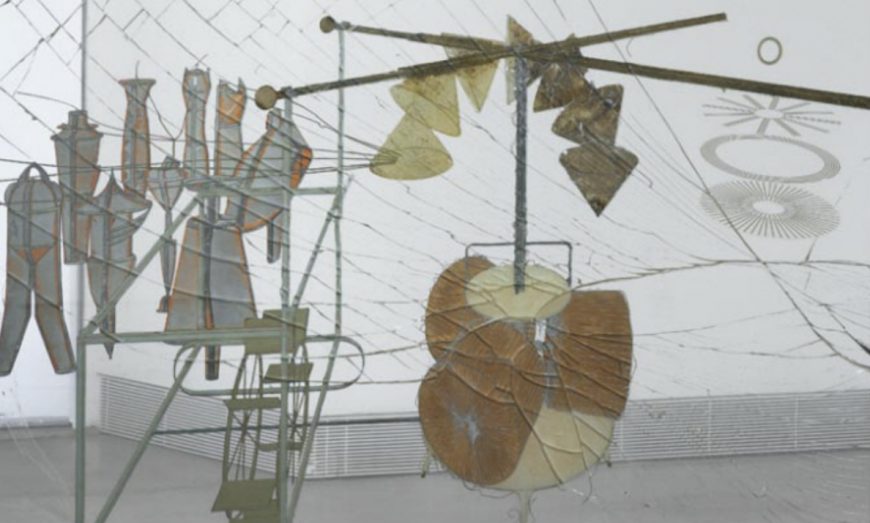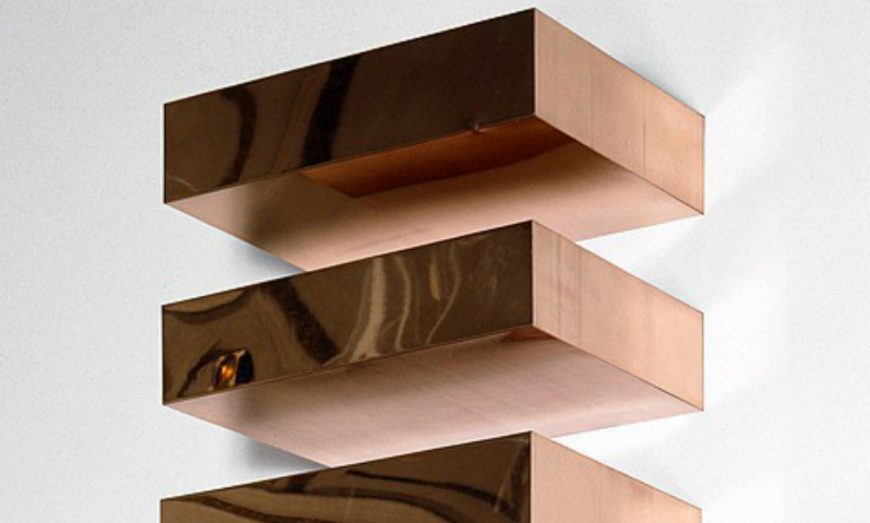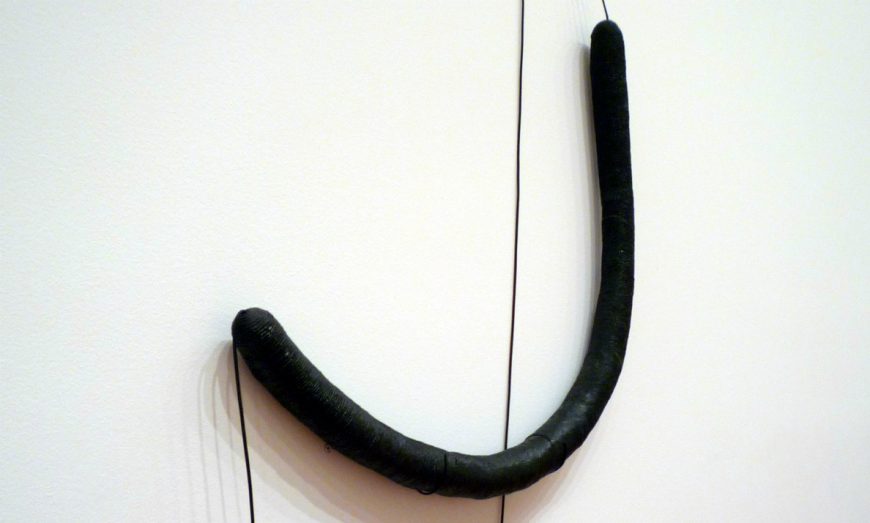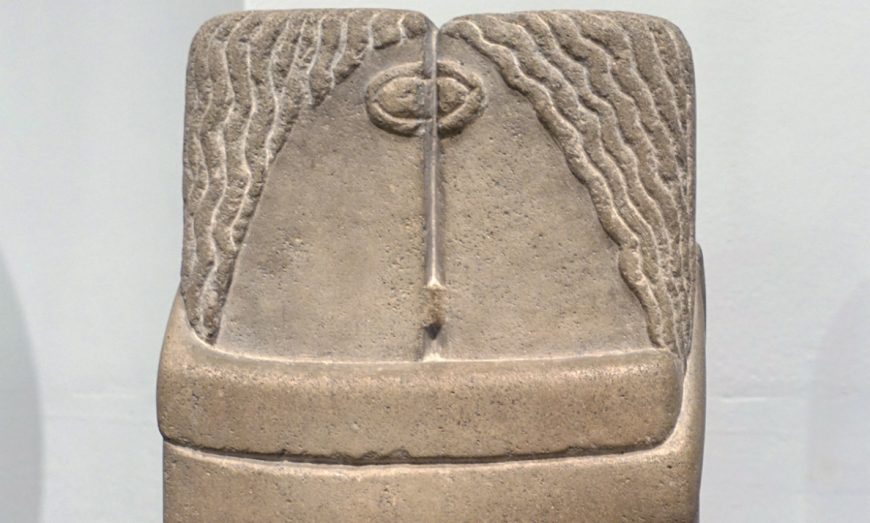Marcel Duchamp, In Advance of the Broken Arm, 1964 (fourth version, after lost original of November 1915) (MoMA)
[0:00] [music]
Dr. Steven Zucker: [0:04] In the years during the First World War, this art movement called Dada began, and one of the most…
Sal Khan: [0:11] Dada.
Dr. Zucker: [0:11] Dada, yeah.
Sal: [0:12] How do you spell that?
Dr. Zucker: [0:13] That’s D-A-D-A. It was really a nonsense word, and that’s why it was called that. The idea was to create a kind of anti-art, to kind of challenge what art was. The world was in flames. The war was raging across Europe, and artists didn’t want to have any part of it. They wanted to show how absurd and how dangerous the world had gotten.
[0:33] And one of the artists who was a Dada artist, whose name was Marcel Duchamp, began to create what we call ready-mades, or what he called ready-mades. Some of them were assisted ready-mades, where he would take two objects that existed in the world and put them together. Some objects were just pure ready-mades, and one of my favorite is called “In Advance of a Broken Arm.”
Sal: [0:55] “In Advance of a Broken Arm.”
Dr. Zucker: [0:56] We’re looking at it on the left here.
Sal: [0:59] You had to explicitly tell me that it was the one on the left.
[1:01] [laughs]
Dr. Zucker: [1:01] Yes, I did.
Sal: [1:03] Just to make this clear, this is “In Advance of a Broken Arm.”
Dr. Zucker: [1:06] That’s exactly right.
Sal: [1:08] You had to point that out because we have a very similar piece, on the right-hand side, right over here, which I just got off of Amazon, which is a snow shovel.
Dr. Zucker: [1:17] And really, they’re not much different at all, are they?
Sal: [1:19] No, they both seem like snow shovels.
Dr. Zucker: [1:21] They are both snow shovels, except that Duchamp has taken his snow shovel out of the garage or out of the hardware store, and relocated it, reframed it and said, “No, this is a ready-made. This is something to look at and to understand within an aesthetic sphere.”
Sal: [1:38] I’m thinking what I think many people are thinking. He did that, and it seems like what he did was a very cynical act, which was like, “Here’s art for you, all you jokers. I’m gonna go buy a snow shovel and stick it in a museum.”
[1:53] I don’t know, I feel like he’s like laughing at people.
Dr. Zucker: [1:56] I think that there is definitely cynicism here. And I think that this is very much related to the objectives of Dada, which was to undermine the way in which we valued art, the way in which we understood art, saying that the world had become a place of chaos, and a kind of dangerous chaos. The artists wanted to, in some ways, have nothing to do with that any longer.
[2:20] So, “How can I most undermine, in a sense, destroy the way in which we had defined art, to create a kind of anti-art?” I think that’s exactly right.
Sal: [2:28] Was he like the first person, because, actually, we just talked about Warhol, and we said, Oh, you know, now someone took a…like a piece of advertising stuck in a museum would feel very derivative. Warhol did that [a] while after Duchamp.
[2:42] To some degree, it feels like now Warhol was derivative because Duchamp went full…Warhol actually had to do some work. He actually painted a soup can. But this guy, he’s way ahead of his time. He literally just bought a snow shovel and showed up.
Dr. Zucker: [2:57] Duchamp would say, however, that finding a perfect ready-made wasn’t an easy thing. He went on a hunt, and that most objects did not suit his definition of what a perfect ready-made would be. He is creating a kind of narrative here. What do you think of when you put that snow shovel together with the title?
Sal: [3:17] To me, it looks like a parody. “In Advance of a Broken Arm.” He went and bought a snow shovel, and he called it “In Advance of a Broken Arm,” which is a very kind of fancy sounding title, which makes you think a little bit. But yeah, I…I…yeah.
[3:36] [laughter]
Dr. Zucker: [3:39] So I think you’re absolutely right. I think impossible. Here’s the even more absurd part. We’re looking at a photograph, not of the original “In Advance of a Broken Arm,” but actually of a later snow shovel that he replaced the original with, after the first had been lost, perhaps to a snowstorm.
Sal: [3:54] Oh, yeah. We read, “August 1964, fourth version, after lost original of November 1915.” So I guess…
Dr. Zucker: [4:04] Can you even have an original?
Sal: [4:06] Exactly, because there’s probably a hundred of those originals.
Dr. Zucker: [4:08] Let’s play this out for a moment. Imagine that this came up to auction, and it went to Sotheby’s. It went to Christie’s. It went to one of the big auction houses. It’s a Duchamp, it’s this important example of Dada. And so the auction is going to start at some very high number, right?
Sal: [4:24] Yes.
Dr. Zucker: [4:25] It’s going to start at two million dollars.
Sal: [4:26] Yes.
Dr. Zucker: [4:27] But then somebody’s…
Sal: [4:28] Is that really what this might go for?
Dr. Zucker: [4:30] Ah…these are priceless objects.
[4:31] [laughs]
Dr. Zucker: [4:31] Except that somebody can walk into the Home Depot or go onto Amazon, as we…
Sal: [4:37] Yes. Or their grandfather’s barn or something.
Dr. Zucker: [4:39] That’s right. Imagine they could get past the guards at Christie’s and walk into the showroom with their own shovel and there would be no difference, physically, between the snow shovel that’s up on the podium, that’s for sale, that’s for auction, that’s reaching these astronomical figures, versus the snow shovel that’s worth $29.99.
Sal: [4:57] That’s a fascinating question because, exactly, they’re physically identical snow shovels and one was touched by Duchamp and placed in a museum and another thousand were not, and because of that this one could go for millions.
Dr. Zucker: [5:14] So you started out by saying, “Is Duchamp being cynical?” In some ways he really is. He’s trying to make, in a sense, the apparatus of the art market transparent. He’s trying to force us to grapple with how we define what art is, and how it’s important, and maybe that our values are misplaced in some way.
[5:31] But he’s also pointing to something else, which is that art is not necessarily, in the 20th century, located in the practice of its making — located in the proficiency of the artist and their brushwork. It’s located in the sort of symbolic language that art can evoke, in the way that art can transform the way that we see the world.
Sal: [5:51] I’m actually becoming a bit of a fan of Duchamp. But I think there’s…and I’m also thinking of becoming an avant-garde artist.
[6:01] [laughs]
[6:05] So what is…in the same…I want to do an art installation called “Breath of Air,” which is, I will go to that location, that little part of volume of the…and I’ll just exhale right there. We’ll put a little placard that someone had exhaled at this point.
[6:18] That would push thinking in art. Where the art object does not even exist…
Dr. Zucker: [6:23] You know what?
Sal: [6:24] It’s been dispersed through the museum.
Dr. Zucker: [6:25] You’ve missed your moment, because art was made like that in the ’70s and ’80s.
Sal: [6:30] Oh, I missed that?
Dr. Zucker: [6:32] You missed it already.
Sal: [6:33] Someone’s already done that? Someone’s literally created art that does not exist?
Dr. Zucker: [6:34] Or art that exists as a performative act.
Sal: [6:40] Oh yeah, yeah, but…yeah. This one’s a difficult one. I’m um, I mean. Yeah. [laughs]
Dr. Zucker: [6:47] This is about as tough as it gets.
Sal: [6:50] What’s your take on it, “In Advance of a Broken Arm?”
[6:56] What do you make…I agree, actually, with everything you said, that he has introduced this, he’s challenging people’s notions of art, challenging the art market, challenging all of these. But, it’s done, in my mind it seems, in a very cynical way. That “I’m going to put a very mundane object on there and make people bid on it and think of it as art.”
[7:11] What do you think of this name, “Advance of a Broken Arm”? That it gets all this special showcase, and the fact that it costs the same as a five-dollar snow shovel you can get at Home Depot?
Dr. Zucker: [7:23] You know, when we think about poetry, for example, we don’t worry about the cost of the typeface. We think about where that poetry brings us emotionally and intellectually. It transforms us, it changes us. And so it’s interesting that in the visual arts, we are still so tied to the handicraft.
[7:42] Duchamp is really distancing art from the handicraft and making it a purely conceptual process. He’s really sort of forcing that issue in an important way that has challenged the 20th century and made contemporary art possible.
Sal: [7:58] That’s interesting. So what you’re saying is that…like poetry, poetry’s really the idea of the poetry? Someone can copy and paste that poem. We can all share that poetry, there’s no physical words there.
[8:10] He did the same, this idea. That’s why he was able to take another shovel and do it again, and again, and again. But still, we say that, but at the same time the art market does not necessarily view it that way. They view this shovel as being somehow holy. Versus the other shovel that was made on the same assembly line is nowhere near as holy.
Dr. Zucker: [8:28] I think that’s exactly right, and in some ways, Duchamp failed.
[8:31] In some ways the avarice of the art market has prevailed despite his attempt to undermine it. We still would auction this at a very high price. We would still differentiate the two shovels. We would still value one over the other.
[8:44] In a sense, we heroicize the object that is somehow connected to the conceptual. Even though I think Duchamp, in some ways, was really focused on separating those things.
Sal: [8:55] Going back to the name. I can kind of buy some of this, in that he’s really challenging what is art and it’s the idea of putting focus on something like this. But at the same time, it seems the title is a little bit uppity. Why didn’t he just call it “Snow Shovel?” Why didn’t he just call it blank? Why did he have to say, “In Advance of a Broken Arm?”
Dr. Zucker: [9:17] I’m not going to pretend to know exactly what his motivations were, but I think that the cynicism that you spoke of before is exactly his point here. He’s almost creating a narrative. Some of my students have said they could imagine that somebody slipped on the ice and broke their arm, and that there really is this narrative…
Sal: [9:32] We could call this piece, “In Advance of a Cherry Pie.”
Dr. Zucker: [9:35] Yeah, absolutely. [laughs]
Sal: [9:35] I can imagine that after working a long day shoveling snow, I will go eat a cherry pie. It would be a fun thing to name this piece of art.
Dr. Zucker: [9:44] I think that notion of absurdity was really central to Duchamp’s practice and what he was interested in. I think he wanted us to bump up against the absurdity of that title and to be challenged by it.
Sal: [9:56] Fascinating.
[9:56] [music]



